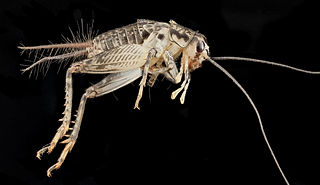
Cerci are paired appendages usually on the rear-most segments of many arthropods, including insects and symphylans. Many forms of cerci serve as sensory organs, but some serve as pinching weapons or as organs of copulation. In many insects, they simply may be functionless vestigial structures.

The genus Sorex includes many of the common shrews of Eurasia and North America, and contains at least 142 known species and subspecies. Members of this genus, known as long-tailed shrews, are the only members of the tribe Soricini of the subfamily Soricinae. They have 32 teeth.

Gryllinae, or field crickets, are a subfamily of insects in the order Orthoptera and the family Gryllidae.

Roesel's bush-cricket, Roeseliana roeselii is a European bush-cricket, named after August Johann Rösel von Rosenhof, a German entomologist.

Jerusalem crickets are a group of large, flightless insects in the genera Ammopelmatus and Stenopelmatus, together comprising the tribe Stenopelmatini. The former genus is native to the western United States and parts of Mexico, while the latter genus is from Central America.

Crickets are orthopteran insects which are related to bush crickets, and, more distantly, to grasshoppers. In older literature, such as Imms, "crickets" were placed at the family level, but contemporary authorities including Otte now place them in the superfamily Grylloidea. The word has been used in combination to describe more distantly related taxa in the suborder Ensifera, such as king crickets and mole crickets.

The bark mantises and ground mantises are praying mantises now placed in the family Eremiaphilidae that are native to the Afrotropics. They are generally light brown but more silvery on the wings. The wings are attractively reticulated, and the veins may be mottled dark and pale. The head is wider than the pronotum, which is rounded anteriorly, and doesn't overlap with the rear of the head. The pronotum is depressed, with its sides more or less parallel, and only a weak supra-coxal bulge is present. The anterior tibia are flattened and greatly expanded longitudinally, and the tibial claw does not fit into a pit between the 1st and 2nd external spines of the anterior femora, as in a few mantis groups.
Miogryllus convolutus is a species of cricket from South America.

Neocurtilla hexadactyla, commonly known as the northern mole cricket, is a species of mole cricket that is native to eastern North America. It also occurs in South America, where it may be an adventive species. Its range extends from the southern reaches of eastern Canada and through the eastern and central United States.

Velarifictorus micado, the Japanese burrowing cricket, is a cricket in the subfamily Gryllinae. It is found in southern Asia, along with an introduced population in the United States. It was first reported in the US in 1959, likely as overwintering eggs in the soil of imported plants, and has since spread all throughout the eastern half of the country. V. micado is considered to be quite passive and non-destructive. Studies have shown that its range has spread northward and may be much more invasive than previously thought.

Miogryllus is a genus of "true crickets" in the subfamily Gryllinae and tribe Gryllini from the Americas. Members of the genus Miogryllus are called striped crickets, also lesser field crickets. There are two North American species of Miogryllus, Miogryllus lineatus, the western striped cricket, and Miogryllus saussurei, the eastern striped cricket.
Arethaea phalangium is a species in the family Tettigoniidae ("katydids"), in the order Orthoptera. The species is known generally as the "eastern thread-leg katydid". It is found in North America.

Tettigoniidea is an infraorder of the order Orthoptera, with six extant families.

Gryllidea is an infraorder that includes crickets and similar insects in the order Orthoptera. There are two superfamilies, and more than 6,000 described species in Gryllidea.

Pardalophora is a genus of Nearctic band-winged grasshoppers in the family Acrididae. There are at least four living species in Pardalophora.

Nomotettix is a genus of pygmy grasshoppers in the family Tetrigidae. There are at least three described species in Nomotettix.
Miogryllus lineatus, the western striped cricket, is a species of cricket in the family Gryllidae. It is found in North America.

Polyphaga saussurei is a cockroach species distributed throughout Central and South Asia and the northeastern Caucasus. It is found in terrestrial habitats, and mainly lives in dry conditions. It can serve as a domestic pest in its natural habitat, although this is not incredibly common.

Haaniella is a genus of the Phasmatodea family Heteropterygidae from Southeast Asia.

Haaniella saussurei is a species of stick insect native to Borneo and a typical representative of the subfamily Heteropteryginae. The occasionally used common name Saussure's Haaniella refers to the species name.

















